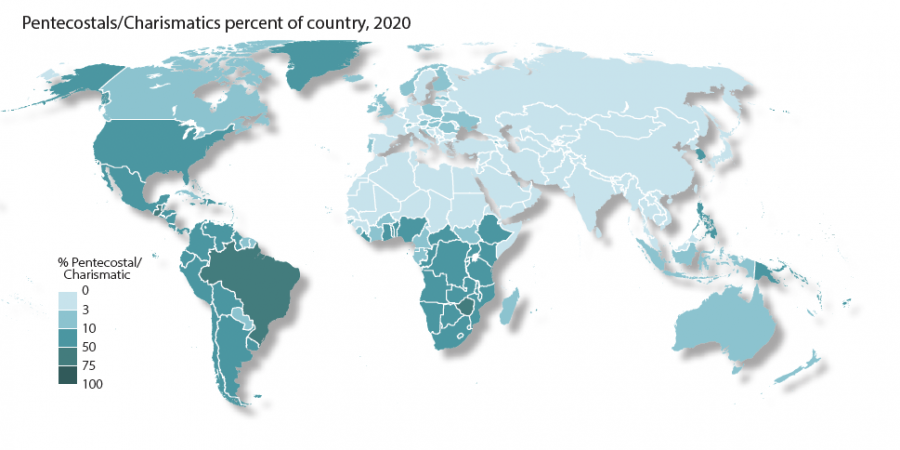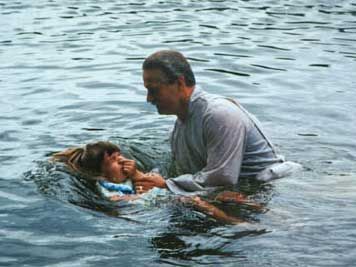When I recently listened to a Podcast on the history of Pentecostalism in the United States, I couldn’t help but wonder how this global Christian manifestation fares in Germany.
I have to admit, that while having a rather vague idea of what Pentecostalism means for the US, I did not know how far it has spread in the country I live in. I didn’t even know how to translate “Pentecostalism” to German. It’s “Pfingsbewegung”, in case you’re wondering.
The Descent of the Holy Spirit
Should you, like me, not be entirely sure what Pentecostalism actually is, let me briefly freshen up your knowledge.
Pentecost refers to the descent of the Holy Spirit on to the early Christians as described in the New Testament of the Bible. In the portrayed incident, which happened on Pentecost, originally a Jewish holiday that is also celebrated in Christianity to this day (in Germany, we know it as Pfingsten), the Holy Spirit bestowed some of God’s powers on to the twelve apostles.
Now, at the dawn of the 20th century, a growing number of individual Christians and congregations in the USA seem to pray for another descent of the Holy Spirit and want to ”experience God’s glory and grace.”
Over time the expectation of a nearing second Pentecost grew stronger. So, Pentecostalism draws a direct line to the early Christian church and takes the Holy Spirit and godly empowerment described in the New Testament of the Bible quite literally.
When a Pentecostal congregation experienced phenomena that resembled the descriptions of the original events in Jerusalem, word traveled quickly and people believed that the second Pentecost had arrived.
From this point on, the new church spread fast and new congregations popped up all over the globe. Only one year after the new church began to spread, the first quasi-Pentecostal service was held in northern Germany.

© Pixabay
Christian Faith and The Pentecostal Movement: An Overview
In the early 20th century, this movement found fertile ground in Germany. Pentecostalism, emphasizing the importance of a personal encounter with the Holy Spirit, has become a distinctive force within the broader Christian faith.
This movement, characterized by fervent worship and a belief in the holy ghost and spiritual gifts, has given rise to numerous new churches across the country.
Before we return to Pentecostalism in Germany, let me quickly describe the makeup of the Christian religion in Germany in the early 20th century.
Back then, roughly 60% of the German population was part of one of the several evangelical churches. The majority of the rest belonged to the Catholic Church, but there were also Orthodox churches and other Christian manifestations.
As Pentecostalism derives from Evangelicalism, it is important to say that the Evangelical churches were not organized in a superordinate organization at the beginning of the 20th century.
Pentecostal Churches: Beyond the Pulpit
Pentecostal churches in Germany have extended their influence beyond traditional worship services to people’s family and personal life. Through various ministries, they address the diverse needs of believers, ranging from educational programs (youth group, Sunday school, etc) to outreach ministries and morning prayer groups.
This holistic approach reflects a commitment to impacting a member’s family and personal life both spiritually and practically, contributing to the movement’s growth and relevance in contemporary German society.
Pentecostal churches often engage in social involvement through informal structures, particularly through small cell groups comprised of a few to a dozen people. These groups, in addition to Sunday worship, convene in homes during the week, just as an extended family.
Many cell groups adopt Jesus’ ethic, considering it their responsibility to care for neighbors (based on Jesus preaching, “Love the Lord your God with all your heart…soul…and mind. This is the first and greatest commandment. And the second is like it: Love your neighbor as yourself.” Matt. 22:37,38) This neighborly love serves as an indirect recruiting tool, attracting new members to join cell groups and, subsequently, attend mass.
The towns of Schmalenberg, Schopp, Matzenbach, and Gimsbach also maintain certain Pentecostal traditions. In Schmalenberg, a unique custom involves boys and men cutting branches from pines, birches, and brooms to create three skirts for the “Quack.”
During the town parade, the Quack wears these skirts from his neck down, along with a hat made of thin rods. On Sunday afternoon, children go from house to house to collect flowers, which they then secure to the hat worn by the Quack.


Diversity and Equality
For the first decade after it sprang up in the US, the movement primarily consisted of impoverished members of Anglo and African-American descent. However, as it evolved into the Apostolic Faith Mission, racial divisions emerged within the church.
In the movement’s early years, women and young people played significant roles, with Aimee Semple McPherson, the founder of the Church of the Foursquare Gospel in the early 1920s in Los Angeles, standing out as the most renowned Pentecostal woman.
Presently, the landscape has shifted, and men tend to predominantly occupy the pulpits within the Pentecostal movement.
Theological Pillars: Word, Worship, and Witness
Central to Pentecostalism in Germany are three key pillars – the Word, worship, and witness. The teachings emphasize a deep engagement with the Bible, services for the Spirit-baptized that invite the manifest presence of the Holy Spirit, and a commitment to sharing the gospel with the world. These pillars serve as the foundation for Pentecostal belief and practice.
Local Churches
The core of the BFP in Germany lies in its local churches, each bearing a unique name that symbolizes diverse historical developments, imprints, and orientations. Despite the variety in nomenclature, these churches unite under shared Pentecostal convictions and experiences grounded in the foundational principles of Word and Spirit.
Together, these churches uphold the centrality of faith and doctrine, emphasizing Jesus’ commission to proclaim the gospel. Referred to as the Church of Jesus, its members bind themselves under the leadership of Jesus Christ, acknowledging the Holy Spirit’s vital role in guiding ministries, imparting gifts, and producing effects in all aspects of church life and ministry.
Leadership Structure: Elders and Pastors
Local BFP churches are led by elders, with the pastor assuming the role of the church leader. The leadership responsibility is characterized by a team-oriented approach, emphasizing complementarity among leaders.
Embracing the Reformation principle of the “priesthood of all believers,” all members are supposed to actively participate in spiritual responsibilities, prayers, and practical cooperation.
Individuals become members of a BFP church by making a personal confession of faith in Jesus Christ and undergoing baptism in water. The essence of BFP churches lies in the vibrant expression of faith in the triune God of the Bible, emphasizing the relevance of God’s Word in both personal and collective church life.

Addressing Decline Through Church Planting
Recognizing the decline in Christian faith and church commitment in the country, the BFP places special emphasis on church planting and the establishment of new churches.
This strategic focus reflects the commitment of the BFP to counteract the challenges faced by the Christian community, actively contributing to the growth and vitality of the Church in Germany. During the last two years, 30 congregations were founded.
How Many Pentecostals Are There Globally?
Determining the precise number of Pentecostals worldwide is a bit challenging due to the diverse nature of this religious movement. Estimates, often citing the World Christian Encyclopedia‘s figure of 500 million, encompass not only Pentecostals but also charismatics and neo-charismatic Christians, collectively known as “renewalists.”
While these figures may be somewhat inflated, it is undeniable that Pentecostalism stands as the world’s fastest-growing Christian movement, ranking second only to Catholicism in terms of numbers. Presently, approximately one-quarter of all Christians, a significant increase from three decades ago when only 6 percent fit this classification, identify as Pentecostals or charismatics.
Geographically, the majority of Pentecostals reside in the developing world. While the United States has nearly 80 million renewalists, including Pentecostals, charismatics, and neo-charismatics, countries such as Brazil boast the highest concentration with an estimated 84 million renewalists. Other significant concentrations include 72 million in China, 41 million in Nigeria, 38 million in India, and 25 million in the Philippines.
In Latin America, Pentecostals are making significant inroads by attracting nominal Catholics, leading some Roman Catholic clergy to refer to them as “sheep stealers.” However, within the Catholic faith itself, there is a vibrant renewal movement that aligns not with Pentecostalism but with the charismatic movement.
The New Pentecostalism in Germany
The “new” movement did not find itself confronted with a united Christian body in Germany. One organization that opposed the spreading of Pentecostalism in Germany was the pietistic “Gemeinschaftsbewegung” (Community Movement), another quite powerful Evangelical church.
It was highly skeptical of the spiritualistic features of Pentecostal services, which saw the congregation members being literally animated by the Holy Spirit.
In an official statement, the Gemeinschaftsbewegung basically accused the Pentecostal churches of heresy. In the Third Reich, many Pentecostal churches and associations, some of which had been prohibited, joined together in larger organizations.
This development continued after World War II. Although the Pentecostal churches are organized in an overarching body, in German law they do not count as one religious Organization, as e.g. the Catholic or the Evangelical Church.
In Germany, singular Pentecostal congregations mostly call themselves “Freikirche” (Free Church), in order to clarify that they are not part of the German Evangelical Church. Theologically, the affiliation to the Pentecostal movement does not mean the different churches and associations cannot differ in their doctrines.
In Germany it quite usual for young women to become Pentecostal pastors in local churches. It is hard to estimate the actual number of Pentecostals in Germany. The larger umbrella organizations count between 3.500 and more than 50.000 members.
FAQs about pentecostalism, Germany and religions in Europe
Here are some of the most frequently asked questions about the German branch of pentecostalism.
What do Germans do on Pentecost?
Pentecost, known as Pfingsten in Germany, is a public holiday. Germans often engage in various outdoor activities, including family gatherings, barbecues, and folk festivals.
Some also attend church services, as Pentecost holds religious significance in both Catholic and Protestant traditions.
Are there Pentecostals in Europe?
Yes, Pentecostals are present in Europe, including Germany. The Pentecostal movement has established congregations and communities in various European countries.
The growth and influence of Pentecostalism is beginning to be noticed in both Western and Eastern European nations, contributing to the religious diversity of the continent.
Summing Up: Pentecostalism in Germany
In conclusion, Pentecostalism in Germany, or Die Pfingstbewegung, is a dynamic force within the broader landscape of German Christianity.
With a rich history, a diverse array of churches and ministries, and a commitment to the transformative power of the Holy Spirit, Pentecostalism continues to shape the spiritual and personal life of believers in Germany.
As the movement evolves, it leaves an indelible mark on the country’s religious and cultural tapestry, inviting both young and old to experience the vibrant presence of the Holy Ghost.

